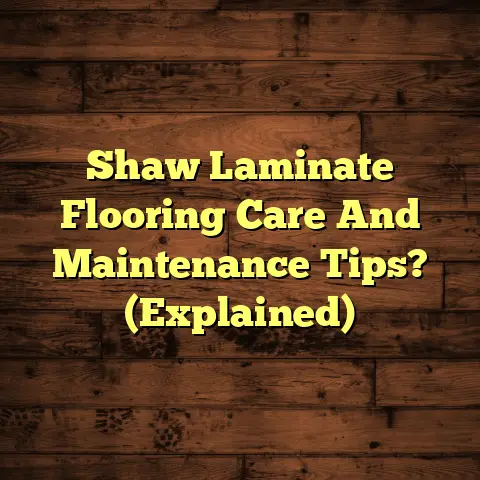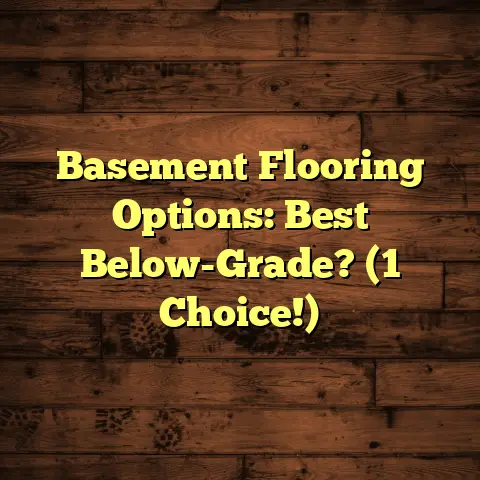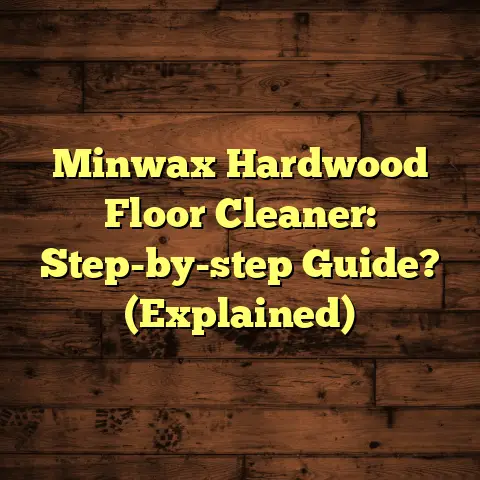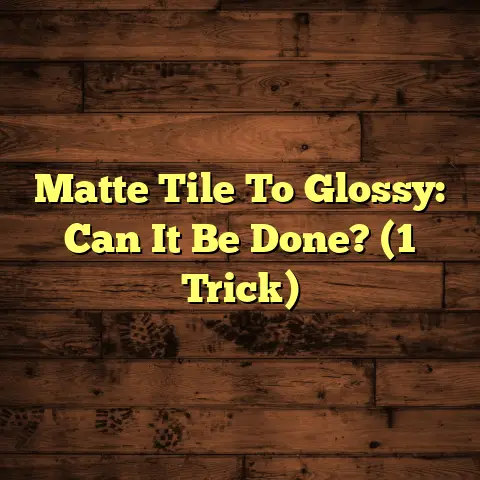Floor Stripping & Buffing: Pro Guide (5 Flaws To Spot!)
(5 Flaws To Spot!)
“The details are not the details. They make the design.” – Charles Eames
And let me tell you, maintaining high-quality flooring is crucial, whether it’s in your cozy home or a bustling commercial space.
Think of your floors as the foundation of your
entire space – they’re the first thing people
notice.
They impact everything from the overall
aesthetic to the value of your property.
That’s where floor stripping and buffing come in.
These processes are like a spa day for your floors,
prolonging their life, boosting their shine, and
generally making them feel loved.
But here’s the thing: like any craft, floor stripping and
buffing have their pitfalls.
I’ve witnessed firsthand
how easily things can go wrong if you’re not careful.
That’s why I’m here to guide you through the process,
arming you with the knowledge to spot the most common
flaws.
We’ll dive deep into what these flaws look
like, why they happen, and most importantly,
how to avoid them.
Whether you’re a DIY enthusiast or simply want to
ensure your hired professional is doing the job
right, this guide is for you.
So, let’s get started
and unlock the secrets to floor perfection!
Section 1: Understanding Floor Stripping
Okay, let’s start with the basics: what is floor
stripping, anyway?
Simply put, it’s the process of
removing old layers of finish, wax, or other
coatings from your floor.
Think of it like hitting the reset button.
It’s
necessary when your floor has accumulated too much
build-up, is heavily scratched, or has yellowed over time.
When is Stripping Necessary?
- Heavy Build-Up: Multiple layers of wax or finish can create a dull, uneven surface.
- Scratches and Scuffs: Deep scratches that buffing can’t remove.
- Yellowing or Discoloration: Aging finishes can become discolored.
- Before Re-Finishing: Stripping is essential before applying a new finish.
Types of Floors That Need Stripping
Not all floors are created equal, and some are more
prone to needing stripping than others.
Here are a
few common types:
- Vinyl Composition Tile (VCT): VCT is super common
in commercial spaces.
It requires regular stripping and waxing to maintain its shine and protect it. - Hardwood: While not as frequent as VCT, hardwood floors may need stripping if the existing finish is severely damaged or you want to change the color.
- Linoleum: Similar to VCT, linoleum can benefit from stripping to remove old coatings and prepare it for a fresh finish.
- Some Tile: Certain types of tile, especially those with applied coatings, might need stripping to remove worn or damaged layers.
Tools and Products of the Trade
Stripping isn’t just about slapping on some chemicals
and hoping for the best.
You need the right tools
and products to get the job done safely and effectively.
Here’s a rundown of what you’ll typically need:
- Stripping Solution: This is the magic potion that
breaks down the old finish.
Choose a stripper specifically designed for your floor type.
Always read the label and follow the manufacturer’s instructions. - Mop and Bucket: For applying the stripping solution.
I recommend using a dedicated mop for stripping to avoid contaminating it with other cleaning products. - Floor Scrubber: This machine helps agitate the stripping solution and loosen the old finish.
- Wet/Dry Vacuum: For removing the dirty stripping solution.
- Scraper: A hand scraper can be helpful for removing stubborn areas of finish.
- Safety Gear: This is non-negotiable!
Always wear gloves, eye protection, and a respirator when working with stripping chemicals.
| Tool/Product | Description
Step-by-Step: The Stripping Process
Alright, let’s get down to the nitty-gritty.
Here’s a
step-by-step guide to stripping your floors like a pro:
- Preparation is Key: Clear the area of all furniture
and obstacles.
Sweep or vacuum the floor thoroughly to remove any loose dirt and debris. - Apply Stripping Solution: Dilute the stripping
solution according to the manufacturer’s instructions.
Apply it liberally to the floor using a mop.
Make sure to work in manageable sections to prevent the solution from drying out. - Let it Dwell: Allow the stripping solution to dwell
on the floor for the recommended time.
This allows it to penetrate and loosen the old finish. - Scrub-a-dub-dub: Use a floor scrubber with a
stripping pad to agitate the solution and loosen the
old finish.
Overlap your passes to ensure complete coverage. - Vacuum Up the Mess: Use a wet/dry vacuum to remove the dirty stripping solution.
- Rinse and Repeat: Rinse the floor thoroughly with
clean water to remove any remaining stripper residue.
You may need to repeat this process several times to ensure all traces of the stripper are gone. - Neutralize (If Necessary): Some stripping solutions
require neutralization after rinsing.
Check the manufacturer’s instructions to see if this step is necessary. - Dry Time: Allow the floor to dry completely before applying a new finish or wax.
Pro Tip:
- Test Patch: Always test the stripping solution in an inconspicuous area first to ensure it doesn’t damage or discolor your floor.
- Ventilation: Make sure the area is well-ventilated to avoid inhaling harmful fumes.
- Patience is a Virtue: Don’t rush the process.
Allow the stripping solution to dwell for the recommended time and take your time scrubbing.
Anecdote Time!
I remember one time, I was hired to strip the VCT
floors in a large retail store.
The floors were in
terrible shape – years of accumulated wax and dirt had
left them looking dull and grimy.
The store owner was skeptical that I could bring them
back to life.
But I assured him that with a little
elbow grease and the right techniques, I could work
miracles.
I followed the steps I just outlined, taking extra
care to scrub the heavily soiled areas.
After several
hours of hard work, the floors were completely stripped
and ready for a new coat of wax.
The store owner was amazed at the transformation.
He
said the floors looked better than they had in years!
That’s the power of proper floor stripping.
Section 2: The Art of Buffing
Now that we’ve covered stripping, let’s move on to the next step in the floor care process: buffing.
Buffing vs. Polishing: What’s the Difference?
It’s easy to get buffing and polishing confused, as
they both aim to improve the appearance of your floors.
But there are key differences:
- Buffing: This process uses a buffing machine with
a soft pad to lightly scrub the floor, removing minor
scratches, scuffs, and dirt.
It enhances the shine and luster of the floor’s finish. - Polishing: Polishing is more aggressive than
buffing.
It uses abrasive compounds to remove a thin layer of the floor’s surface, smoothing out deeper scratches and imperfections.
Polishing is typically done on harder surfaces like stone or concrete.
Think of it this way: Buffing is like a gentle exfoliation for your skin, while polishing is like a deeper chemical peel.
Benefits of Buffing
Buffing offers a range of benefits for different floor materials:
- Enhanced Shine: Buffing brings out the natural shine of your floor, making it look brighter and more inviting.
- Scratch Removal: It can remove minor scratches and scuffs, restoring the floor’s smooth surface.
- Dirt Removal: Buffing helps remove embedded dirt and grime, improving the overall cleanliness of the floor.
- Protection: Buffing can help protect the floor’s finish from wear and tear, extending its lifespan.
- Improved Traction: In some cases, buffing can improve the traction of the floor, making it safer to walk on.
Buffing Equipment 101
Like stripping, buffing requires the right equipment. Here’s what you’ll typically need:
- Buffing Machine: This is the workhorse of the
operation.
Buffing machines come in various sizes and speeds.
Choose one that’s appropriate for the size of your floor and the type of material. - Buffing Pads: Buffing pads come in different
materials and textures.
The type of pad you use will depend on the type of floor you’re buffing and the desired result.
Common types include:- White Pads: For light buffing and polishing.
- Beige Pads: For general-purpose buffing.
- Red Pads: For more aggressive buffing and scrubbing.
- Black Pads: For stripping and heavy-duty scrubbing.
- Dust Mop or Vacuum: For removing dust and debris before and after buffing.
- Floor Cleaner (Optional): You may need a floor cleaner to remove stubborn dirt or stains before buffing.
The Buffing Process: Step-by-Step
Ready to get your buff on? Here’s a step-by-step guide to buffing your floors:
- Prep Time: Clear the area of any obstacles and sweep or vacuum the floor thoroughly.
- Choose Your Pad: Select the appropriate buffing pad for your floor type and desired result.
- Pad It Up: Attach the buffing pad to the buffing machine.
- Buff Away: Start buffing in one corner of the room,
overlapping your passes as you go.
Maintain a steady pace and apply even pressure. - Dust Removal: After buffing, use a dust mop or vacuum to remove any dust or debris.
- Admire Your Work: Step back and admire your newly buffed floors!
Testimonial Time
I once worked with a property manager who was struggling
to keep the VCT floors in her building looking clean and
shiny.
She had tried everything – mopping, scrubbing,
even polishing – but nothing seemed to work.
I suggested she try buffing the floors regularly.
She
was hesitant at first, thinking it would be too time-consuming.
But I convinced her to give it a try.
After just one buffing session, she was amazed at the
difference.
The floors looked brighter, cleaner, and
shinier than they had in years.
She started buffing the floors on a regular basis, and
the results were even more impressive over time.
The
floors stayed cleaner longer, and they required less
frequent stripping and waxing.
She told me that buffing had saved her time, money, and
a whole lot of headaches.
That’s the power of proper
buffing!
Section 3: Common Flaws in Floor Stripping & Buffing
Alright, now for the part you’ve been waiting for:
the common flaws in floor stripping and buffing.
I’ve seen these mistakes happen time and time again,
and they can lead to some pretty frustrating results.
Let’s dive in and learn how to spot them and, more importantly, how to avoid them.
Flaw 1: Incomplete Stripping
What it looks like: Incomplete stripping occurs when
the old finish isn’t completely removed from the floor.
You might notice patchy areas where the old finish is
still visible, or a dull, uneven appearance overall.
Sometimes, it looks like a faint, hazy film remains on
the floor.
Consequences: Incomplete stripping can have several negative consequences:
- Poor Adhesion: The new finish won’t adhere properly to the floor, leading to peeling, chipping, and premature wear.
- Uneven Appearance: The floor will have an uneven, patchy appearance, which can be unsightly.
- Increased Maintenance: The floor will be more difficult to clean and maintain, as dirt and grime can become trapped in the remaining old finish.
How to Spot It:
- Visual Inspection: Carefully inspect the floor
after stripping.
Look for any areas where the old finish is still visible. - Touch Test: Run your hand over the floor.
If you feel any sticky or rough patches, that’s a sign that the old finish hasn’t been completely removed. - Water Test: Pour a small amount of water on the
floor.
If the water beads up or doesn’t spread evenly, that’s another sign of incomplete stripping.
The Importance of Thoroughness:
Thoroughness is key to avoiding incomplete stripping. Make sure you:
- Use the Right Stripping Solution: Choose a stripper that’s specifically designed for your floor type.
- Follow the Instructions: Carefully follow the manufacturer’s instructions for dilution and dwell time.
- Scrub Thoroughly: Use a floor scrubber with a stripping pad to agitate the solution and loosen the old finish.
- Rinse Completely: Rinse the floor thoroughly with clean water to remove any remaining stripper residue.
- Don’t Rush: Take your time and don’t cut corners.
Flaw 2: Over-Buffing
What it is: Over-buffing happens when you buff a floor
for too long or with too much pressure.
This can damage
the floor’s finish, leaving it looking dull, hazy, or even scratched.
Detrimental Effects:
- Damaged Finish: Over-buffing can wear away the floor’s finish, leaving it vulnerable to scratches, stains, and other damage.
- Hazy Appearance: The floor may develop a hazy or cloudy appearance, reducing its shine and clarity.
- Scratches: Aggressive buffing can actually create fine scratches in the floor’s surface.
Indicators of Over-Buffing:
- Dullness: The floor loses its shine and appears dull.
- Haze: A hazy or cloudy film appears on the floor.
- Scratches: Fine scratches are visible on the floor’s surface.
- Heat: The floor becomes excessively hot during buffing.
Tips for Avoiding Over-Buffing:
- Use the Right Pad: Choose a buffing pad that’s
appropriate for your floor type and the desired result.
Avoid using overly aggressive pads. - Apply Light Pressure: Use light, even pressure when buffing.
Let the machine do the work. - Keep it Moving: Don’t stay in one spot for too long.
Keep the buffing machine moving to avoid overheating the floor. - Inspect Frequently: Check the floor’s appearance
frequently during buffing.
If you notice any signs of over-buffing, stop immediately.
Flaw 3: Improper Equipment Use
The Problem: Using the wrong tools for the job can lead
to ineffective results and even damage your floors.
Think of it like trying to cut a steak with a butter knife –
it’s just not going to work!
Ineffective Results:
- Poor Stripping: Using a weak stripping solution or the wrong type of stripping pad can result in incomplete stripping.
- Uneven Buffing: Using a buffing machine that’s too powerful or a buffing pad that’s too aggressive can lead to uneven buffing and damage to the floor.
- Damage to the Floor: Using the wrong equipment can cause scratches, gouges, and other damage to the floor’s surface.
Selecting the Right Equipment:
- Stripping Solution: Choose a stripping solution
that’s specifically designed for your floor type.
Read the label carefully and follow the manufacturer’s instructions. - Stripping Pads: Use stripping pads that are compatible with your floor scrubber and the type of finish you’re removing.
- Buffing Machine: Choose a buffing machine that’s appropriate for the size of your floor and the type of material.
- Buffing Pads: Select buffing pads that are appropriate for your floor type and the desired result.
Flaw 4: Inconsistent Finish
What It Is: An inconsistent finish means that some
areas of the floor look different from others.
You might
see variations in shine, color, or texture.
Undermining the Overall Appearance:
- Unprofessional Look: An inconsistent finish can make your floors look unprofessional and poorly maintained.
- Reduced Value: Inconsistent floors can detract from the overall value of your property.
- Eye Sore: Let’s face it, inconsistent floors are just plain ugly!
Guidance on Achieving a Uniform Look:
- Proper Preparation: Make sure the floor is thoroughly cleaned and prepped before stripping or buffing.
- Even Application: Apply stripping solution and finish evenly across the entire floor.
- Overlapping Passes: Overlap your passes when stripping and buffing to ensure complete coverage.
- Consistent Pressure: Apply consistent pressure when buffing to avoid uneven results.
- Proper Equipment: Use the right equipment for the job.
Flaw 5: Neglecting Safety Protocols
The Importance of Safety: Let’s be real, floor stripping
and buffing can involve some pretty harsh chemicals and
powerful equipment.
Neglecting safety protocols can lead
to serious injuries.
Common Safety Oversights:
- Not Wearing Protective Gear: Failing to wear gloves, eye protection, and a respirator can expose you to harmful chemicals.
- Poor Ventilation: Working in a poorly ventilated area can lead to inhalation of toxic fumes.
- Improper Handling of Chemicals: Mixing chemicals improperly or storing them incorrectly can create dangerous reactions.
- Not Following Instructions: Ignoring the manufacturer’s instructions for using chemicals and equipment can lead to accidents.
Potential Consequences:
- Skin Irritation: Exposure to stripping chemicals can cause skin irritation, burns, and allergic reactions.
- Eye Damage: Splashing chemicals in your eyes can cause serious eye damage, including blindness.
- Respiratory Problems: Inhaling toxic fumes can cause respiratory problems, such as coughing, wheezing, and shortness of breath.
- Injuries from Equipment: Improper use of floor scrubbers and buffing machines can lead to cuts, bruises, and broken bones.
Always, Always, Always:
- Read the Labels: Carefully read the labels on all chemicals and equipment before using them.
- Wear Protective Gear: Always wear gloves, eye protection, and a respirator when working with stripping chemicals.
- Ventilate the Area: Make sure the area is well-ventilated to avoid inhaling harmful fumes.
- Follow Instructions: Follow the manufacturer’s instructions for using chemicals and equipment.
- Be Aware of Your Surroundings: Keep children and pets away from the work area.
Section 4: Conclusion
We’ve covered a lot of ground in this guide.
We’ve explored the ins and outs of floor stripping
and buffing, from the tools and techniques to the
common flaws that can derail your efforts.
The key takeaway here is that attention to detail and adherence to best practices are essential for achieving beautiful, long-lasting results.
Ignoring these flaws can lead to a host of problems, from poor adhesion and uneven finishes to damaged floors and even personal injuries.
By taking the time to educate yourself and either seek professional help or tackle the job yourself with care, you can ensure that your floors remain in optimal condition for years to come.
Remember, your floors are an investment.
Taking care
of them properly will not only enhance the aesthetic
appeal of your space but also protect your investment
for the long haul.
So, go forth and strip and buff with confidence, knowing that you’re armed with the knowledge to avoid these common pitfalls.
Happy flooring!





